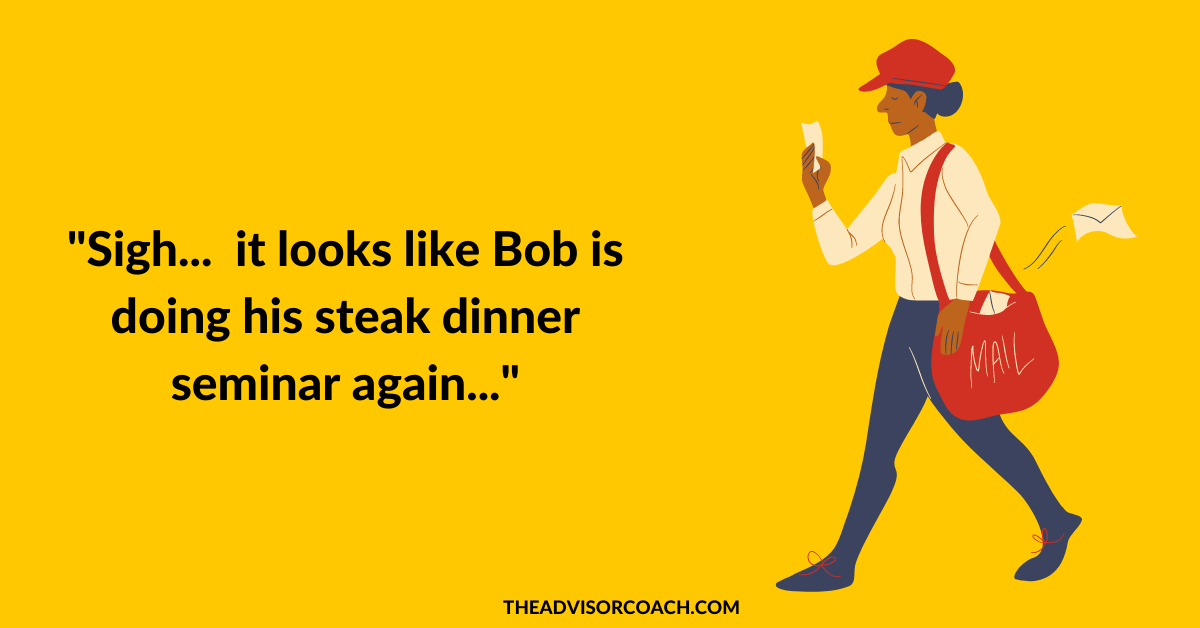5 Ways Financial Advisors Can Improve Direct Mail Marketing ResultsDirect mail is awesome.
When most financial advisors put together a marketing plan, they often ignore direct mail in favor of other communication methods, like social media or digital marketing. Because thousands of professionals are turning to digital marketing, direct mail is perhaps more of a gold mine than ever before. Today, everyone’s inbox is full of mail. All types of mail – family, friends, colleagues, junk mail, spam, flagged, important, must-read, unread, and so on. I know people who have created separate email accounts just to weed out all the unwanted clutter. Social media is the same way. We have hundreds, if not thousands, of connections online that are all posting, messaging, updating, and commenting nonstop. Then, at least once a day (for most of us), we go to the lowly mailbox… the real one. You pull down that creaky door, peek inside, and guess what? There’s likely less stuff in there this year than in all the years past. What gives? Email and social media definitely have their place, and they can reach tons of people quickly with a relatively low cost. But the question is: do they get clients? I would much rather talk to 100 people with a high likelihood of converting than 1,000 people with a small likelihood of converting, and I’m sure you would too. According to the United States Post Office and the Direct Marketing Association, 70% of Americans said snail mail is more personal than the internet. People trust it and like it more. How can you leverage this powerful tool to your advantage? Here are a few ways: 1. Don't Be Afraid to Experiment With Postcards Vs. Envelopes.I read a few articles about financial advisor mailing before writing this piece and it disturbed me to see that quite a few blindly advocated sending out postcards. I want to make it perfectly clear that you should rarely accept any advice (even mine) as gospel. Test it for yourself.
The idea of using postcards is a good one; it’s cheaper than the letter, and it’s more likely to get read since there’s no envelope covering it. Since the number one goal of direct mail marketing is to get the recipient’s attention, postcards seem like a good idea. But postcards feel cheap. They just give the impression that you’re mailing them to every single person in the zip code. Letters in a physical envelope can include different headlines, long copy, and more literature. Marketing consultants can read academic studies all day long, but without real-world experience, the studies can lead them astray. Here’s what I mean: if you read the studies, you will be led to believe that postcards will outperform letters all day long. In fact, there’s a DMA study that says that oversized envelopes have the best response rate (think birthday cards) at 5.0%, then followed by postcards at 4.25%, while letter-sized envelopes have a 3.5% response rate. You might think that postcards are a no-brainer because they are cheaper and have a better response rate, but you might be wrong. The financial services industry is a different beast. It’s not a carpet cleaning business. Postcards might work for carpet cleaning because you can send out thousands to upscale neighborhoods, attach a few coupons, and get the phone to ring off the hook. Then, when these studies are being conducted, these businesses are included in the data and skew it upward. When it comes to postcards, I have seen wild success and I have seen epic waste and failure. However, in my experience, the letter-sized envelope is a noble workhorse that proves to be safe and steady. Test the two for yourself. Assume nothing. Let’s say you send out 1,000 postcards at a total cost of $300 (which is more or less accurate, depending on who you use) and you get a low response rate of .5%. That’s 5 qualified leads at a cost of $60 per lead. But what if you sent out 1,000 direct mail pieces at a cost of $900 and got a 2% response rate? That means you’d get 20 qualified leads at a cost of $45 per lead – 25% cheaper. I don’t know about you, but that money is better off in my pocket than in the mail company’s pocket. That leads me to the second tip… 2. Test Everything.In addition to testing postcards vs. envelopes, you should be testing various offers, literature, formats, and audiences.
Marketing is all about trial and error, but when testing, only test one thing at a time. For example, change ONLY the headline, or the font, or the size of the postcard. If you do it all at once, you won’t be able to track what actually contributed to the results, for better or worse. Just make sure that you’re using a large enough sample size to improve your statistical confidence. I recommend a minimum of 1,000 for split tests, which means that each A/B test you run will cost a few hundred to a few thousand dollars. I say this so you have realistic expectations going in and so that you don’t get discouraged when you’re losing a small amount of money or just breaking even at first. Understand that it might take you a few thousand dollars to scientifically find a working formula, but once you do, it’ll be a money machine. 3. Never Confuse Response For Results.This is a killer of dreams and budgets. Responses feel good. They’re phone calls and questions and answers to the “where did you find us” bubbles that say “your mailer”. That means the mail campaign is working, right?
Not necessarily – make sure you know the difference between responses and results. For example, in lead generation, you can generate a lot of leads with a free offer (response) but how many of those leads will convert into clients (results)? Results are the things that actually make you money, and results are the ONLY thing that should be measured against your marketing expenses to make sure that your machine is working 4. Compare Your Direct Mail Campaign Against Other Advertising Methods.I may be a marketing consultant, but I am business-oriented. I enjoy the process of getting the largest return possible for money invested, and you can do the same for your direct mail. I already told you that you should be comparing different campaigns and variables, but you should also be comparing your direct mail campaign against other advertising efforts.
If you are running an advertising campaign at the same time as your direct mail campaign, compare them on a “cost per X” basis. This is the common denominator of all marketing – how many greenbacks does it take to get a result, response, etc. Let’s assume that I’m running an advertising campaign and a direct mail campaign at the same time. Let’s also assume that I close 20% of all my prospects in both scenarios, which means 20% of my responses will turn into results. Advertising campaign Cost: $10,000 Responses: 250 Results: 50 Cost per response: $40 Cost per result: $200 Direct mail campaign Cost: $5,000 Responses: 200 Results: 40 Cost per response: $25 Cost per result: $125 In this example, I am “buying” new clients for $200 with the advertising campaign and for $125 with the direct mail campaign. Having this information will give me the confidence to pump more money into the direct mail campaign and less into the advertising campaign, allowing my dollars to stretch a little more. Doing this type of math early on, then testing the variables against each other, can save you hundreds of thousands of dollars over the course of your career. 5. Think Boring.Not only does full color drive up your printing costs, but pretty mail rejects involvement. People will say “isn’t that pretty?” and then dump it into the trash. When it comes to direct mail, think boring.
Pretty mail rejects involvement. Boring direct mail gives no pretense of cleverness. The sole objective is to generate phone calls and nothing else. You are not trying to win an award; you are trying to get business. A lot of direct mail marketers will succeed IN SPITE OF their design, not because of it. Boring mail works because there’s no design to get in the way. Mail is not for branding, it is for direct response. Do what works to get responses. BONUS: Use a stamp. People can tell when something has been mass-mailed. If you put a live stamp on the envelope, it looks like it came from a real person, which means it will more than likely get opened. The academic studies often don’t account for live stamp vs. mass mailing, contributing to the letter's lower response rate. P.S. If you're a financial advisor who wants to get more clients from LinkedIn, make sure you check out How to Get Clients With LinkedIn: How Financial Advisors Can Set Appointments and Convert Prospects With LinkedIn |



